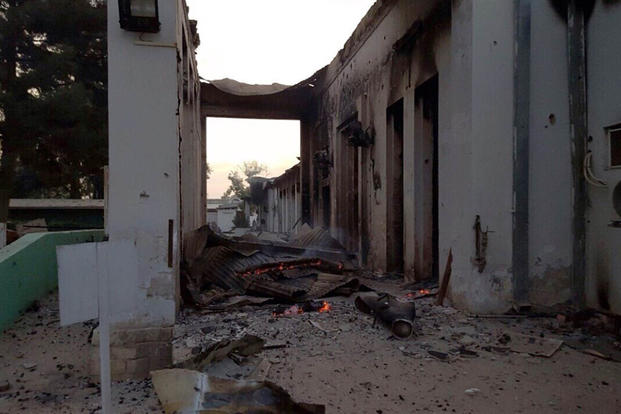Several U.S. Special Operations air and ground team members have been suspended for a stunning and fatal series of mistakes that resulted in an AC-130 gunship repeatedly hitting the wrong target in the Kunduz hospital strike last month that killed 30 people, the U.S. commander in Afghanistan said Wednesday.
"No nation does more to prevent civilian casualties than the United States, but we failed to meet our own high standards on October 3" in the airstrike on the Doctors Without Borders trauma center, said Army Gen. John Campbell, commander of the NATO Resolute Support Mission and U.S. Forces- Afghanistan.
"This was a tragic, but avoidable accident caused primarily by human error," Campbell said in giving a long-awaited preliminary report on the findings and recommendations of a continuing Article 15-6 investigation into the incident under the Uniform Code of Military.
The investigation led by Army Maj. Gen. William Hickman, who is not in Campbell's command, could potentially lead to courts-martial.
In response, Doctors Without Borders said in a statement, "The frightening catalogue of errors outlined today illustrates gross negligence on the part of U.S. forces and violations of the rules of war."
In a briefing from Kabul, Campbell was circumspect to avoid the appearance of "undue command influence" on possible court proceedings, but said "I can tell you that those individuals most closely associated with the incident have been suspended from their duties, pending consideration and disposition of administrative and disciplinary matters."
Campbell and Pentagon officials did not say how many had been suspended, but military sources said the number could be as many as a dozen.
Campbell cited but did not identify a Special Forces commander on the ground in Kunduz, who allegedly relied on faulty targeting information from a Special Operations joint terminal attack controller, or JTAC, and failed to verify it. The New York Times reported that a Special Forces captain in Kunduz had been relieved of his command Wednesday.
Campbell left the briefing after making a statement and did not take questions. Army Brig. Gen. William Shofner, the public affairs chief in Kabul who followed Campbell to the podium, did not respond directly or simply ignored questions on whether Campbell himself had been questioned as part of the investigation and could be subject to discipline.
Shofner also did not respond directly when asked repeatedly whether the U.S. would now support an independent international investigation of the Kunduz strike as requested from the start by Doctors Without Borders (Medecins Sans Frontieres, or MSF).
Campbell outlined a chain of events in the early morning hours of Oct. 3 that ended in a scene of carnage at the hospital, where intensive care unit patients burned in their beds and others attempting to flee were cut down by the AC-130's mini-guns, according to MSF.
Campbell also pointed out that the situation in Kunduz, the capital of Kunduz province, in the early morning hours of Oct. 3 was chaotic. The Taliban had overrun the city. Special Forces teams assisting the Afghan National Security Forces had been engaged in combat for at least five days.
The initial casualty reports said that at least 22 were killed at the hospital but Campbell said that a U.S. Combat Casualty Assessment Team had verified what MSF had been saying for several weeks -- that 30 were killed and 37 were wounded. MSF said the fatalities included 13 MSF staff and 10 patients.
MSF officials said the AC-130 made at least five passes and the airstrikes continued for about an hour. The investigation said the airstrikes lasted for about 29 minutes.
"The report determined that the U.S. strike upon the MSF Trauma Center in Kunduz City, Afghanistan, was the direct result of human error, compounded by systems and procedural failures," Campbell said, but he stressed that the tragedy was the result of mistakes and not any intention by U.S. forces to hit a hospital.
"U.S. forces would never intentionally strike a hospital or other protected facility," Campbell said. The preliminary report from Campbell made no mention of allegations attributed to Afghan officials that a Taliban operative may have been firing from the hospital. MSF officials have heatedly denied the allegations.
The mistakes outlined by Campbell began before the Air Force Special Operations AC-130 took off, the preliminary report showed.
The aircraft rushed to take off 69 minutes early in response to a "troops in contact" situation. As a result, the aircrew was proceeding "without conducting a normal mission brief or securing crucial mission-related materials, including the no-strike designations which would have identified the location of the MSF Trauma Center," the report said.
The AC-130 was then diverted from the "troops in contact" incident to Kunduz but experienced an electronics systems failure during the flight, "preventing the operation of an essential command and control capability and eliminating the ability of the aircraft to transmit video, send or receive Email, or send or receive electronic messages."
On the ground, a U.S. Special Forces commander had received a request for U.S. close air from Afghan security forces for a raid on a building former occupied by the National Directorate for Security, the Afghan intelligence agency.
The Taliban were believed to have taken over the building, which was several hundred meters from the hospital. The NDS building was the intended target of the AC-130 strike.
The U.S. Special Forces commander through his JTAC "provided the aircraft with the correct coordinates to the NDS headquarters," the report said, "but when the aircrew entered the coordinates into their fire control systems, the coordinates correlated to an open field over 300 meters from the NDS headquarters."
"The Investigating Officer found that the aircrew visually located the closest large building near the open field, which we now know was the MSF Trauma Center," and the AC-130 began a series of strikes.
"The aircrew concluded, based on the JT AC's description of a large building near the field, that the MSF Trauma Center was the NDS headquarters, the report said. "Tragically, this misidentification continued throughout the remainder of the operation, even though there were some contradictory indicators."
One minute before the AC-130 began firing, the aircrew transmitted to operational headquarters at Bagram airfield north of Kabul that they were about to engage a target. They gave the coordinates of the MSF hospital.
"The headquarters was aware of the coordinates for the MSF Trauma Center and had access to the no-strike list, but did not realize that the grid coordinates for the target matched a location on the no-strike list or that the aircrew was preparing to fire on a hospital," the preliminary report said.
In its statement, MSF said that "The U.S. version of events presented today leaves MSF with more questions than answers."
-- Richard Sisk can be reached at richard.sisk@military.com



























